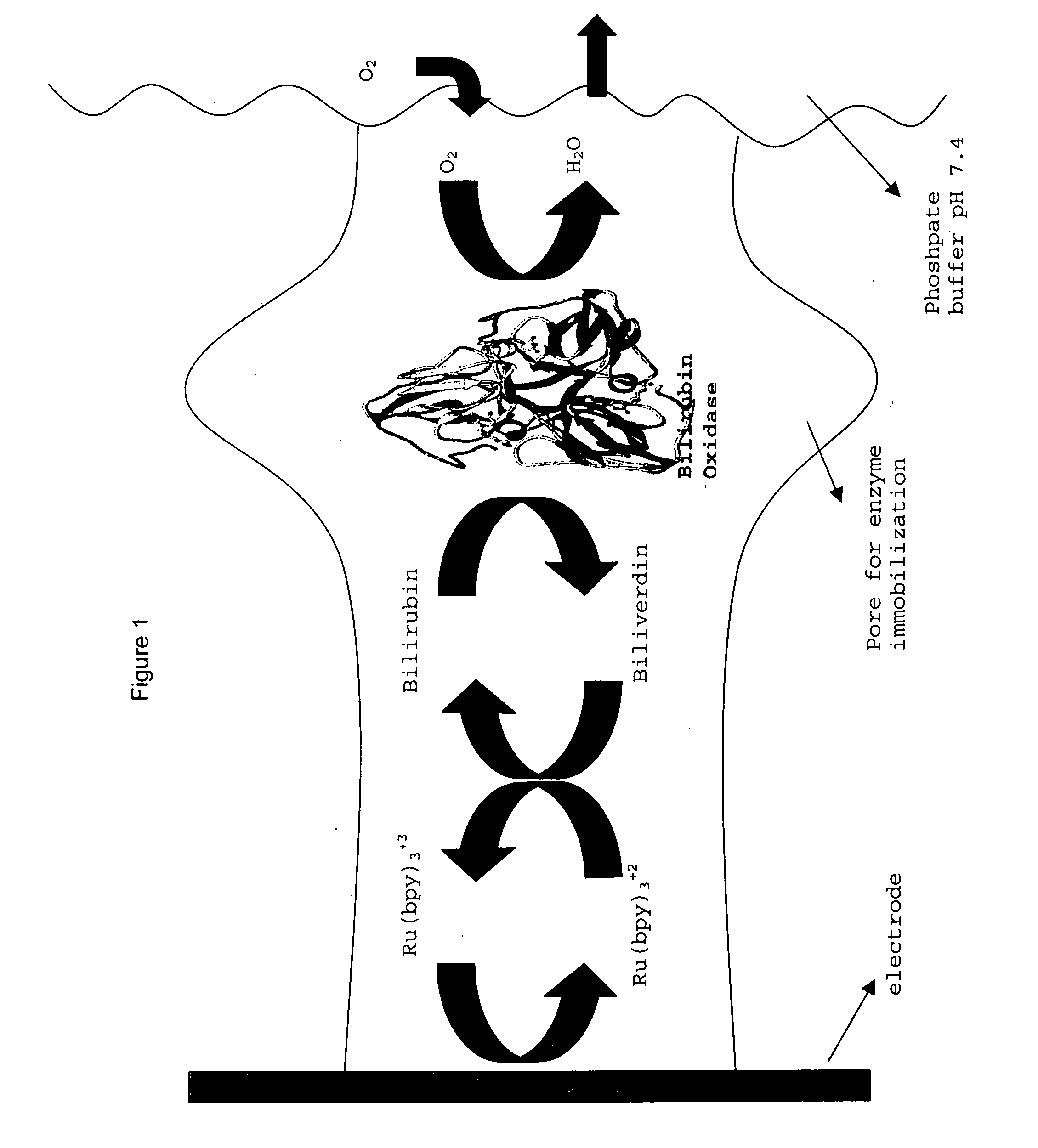Immobilized enzymes in biocathodes
a biocathode and enzyme technology, applied in the field of biocathodes, can solve the problems of low volumetric catalytic activity of the whole organism, impractical power density output, nafion® has not been successful at immobilizing enzymes at the surface of biofuel cell electrodes,
- Summary
- Abstract
- Description
- Claims
- Application Information
AI Technical Summary
Benefits of technology
Problems solved by technology
Method used
Image
Examples
example 1
Preparation of Enzyme-Immobilized Salt-Extracted Membranes
Preparation of Ru(bpy)3+2 / Nafion I
[0188] Ru(bpy)3+2 / Nafion I is made by the direct addition of Ru(bpy)3+2 salt to Nafion suspension (mixture casting).
[0189] To prepare the Ru(bpy)3+2 / Nafion I Salt-Extracted Membrane (“Nafion I”), 0.15 millimols of Ru(bpy)3+2 were added to 4 ml of Nafion®), mixed well for ˜3 to 4 hours by vortexing and using a sonicator in a constant temperature water bath. The mixture was then poured into a weighing boat to dry overnight. Once dry, the Ru(bpy)3+2 / Nafion® mixture was salt extracted by soaking into deionized water using vortex, followed by centrifugation. The extracted solution went from orange to clear when all salt is extracted. The salt-extracted membrane was rinsed and dried, then redissolved in 4 ml of 80% Ethanol (can be redissolved in a mixture of lower aliphatic alcohols containing up to 30% water).
[0190] The cathode enzyme was immobilized in the Ru(bpy)3+2 / Nafion I Salt-Extracted ...
example 2
Preparation of Electrodes
Preparation of Ru(bpy)3+2 / Nafion III on glassy carbon electrodes
[0196] To prepare the cathode enzyme / membrane casting solution, ˜1 mg of Bilirubin and ˜0.5-1 mg of Bilirubin Oxidase were added to 100 ml Ru(bpy)3+2 / Nafion III Salt-Extracted Membrane (supra) and mixed well (in this case, vortexed for 20 minutes). 2 ml of the cathode enzyme / membrane casting solution was applied to polished glassy carbon electrodes (3 mm in diameter) and allowed to dry. Once dry, the cathode enzyme / membrane / carbon electrode was soaked for 3 h in a N2-degassed Ru(bpy)3+2 solution. After the exchange of TBAB for Ru(bpy)3+2, the carbon electrodes were introduced into a N2-degassed Phosphate buffer of pH 7.4 and allowed to soak for 1 h. After equilibration, the cathodes were tested by cyclic voltammetry at scan rates of 0.05 and 0.1 V / s. Then, the buffer solution was saturated with O2 for 10 min and the cathodes were tested as above.
Preparation of Ru(bpy)3+2 / Nafion III on 1 cm2...
example 3
[0200] A prototype biofuel cell (FIG. 11) was built comprising a bioanode, which comprises an alcohol dehydrogenase immobilized in TBAB-modified Nafion® (as described in patent applications 60 / 429,829, 60 / 486,076 and Ser. No. 10 / 617,452), and the instant Nafion III membrane comprising bilirubin oxidase, bilirubin and Ru(bpy)3+2 (see FIG. 1 for a depiction of the dual function biocathode membrane). Initial tests of this non-optimal biofuel cell, which has a PEM (Nafion® 117) membrane that separates the anode and cathode solutions and in which catalyst loading was only ˜28% of the membranes depicted in the voltammogram experiments (supra), indicated that the open circuit potentials ranged from 0.4179-0.819 Volts and the maximum current density ranged from 0.224 mA / cm2 to 2.23 mAmps / cm2 and the maximum power was 0.951 mW / cm2 (see FIG. 12, which depicts the power curve for this prototype).
PUM
| Property | Measurement | Unit |
|---|---|---|
| standard reduction potentials | aaaaa | aaaaa |
| pH | aaaaa | aaaaa |
| diameter | aaaaa | aaaaa |
Abstract
Description
Claims
Application Information
 Login to View More
Login to View More - R&D
- Intellectual Property
- Life Sciences
- Materials
- Tech Scout
- Unparalleled Data Quality
- Higher Quality Content
- 60% Fewer Hallucinations
Browse by: Latest US Patents, China's latest patents, Technical Efficacy Thesaurus, Application Domain, Technology Topic, Popular Technical Reports.
© 2025 PatSnap. All rights reserved.Legal|Privacy policy|Modern Slavery Act Transparency Statement|Sitemap|About US| Contact US: help@patsnap.com



